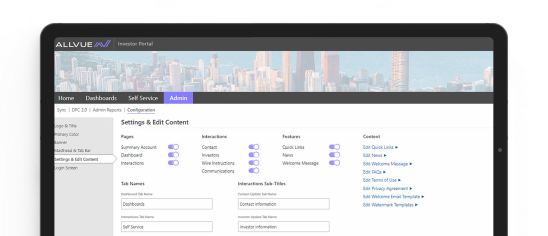
By: Allvue Team
March 18, 2024
Last month, Allvue attended and sponsored the Fund Finance Association’s 13th annual Fund Finance Symposium in Miami Beach, Florida. The annual symposiums bring together investors, fund managers, bankers and lawyers for education and networking within the fund finance market, attracting nearly 2,000 attendees.
At this year’s event, Allvue’s Brendan Cahill, Product Manager, Fund Finance led a bespoke panel, “Beyond Excel: New Technologies Available to Fund Finance”.
Brendan joined industry peers Steve Markovinovic, Director of Equity and Fund Structures Trading at Barclays; Bill McMahon, Executive Director, Credit at Lionpoint Group; Rafael Vistan, Managing Director at MUFG; Nake Grewal, Head of Underwriting at Wells Fargo; and Hamid Aguerbal, Global Structured Credit & Solutions of Natixis Corporate & Investment Banking. The group covered topics including:
- How firms are leveraging new technologies
- Managing portfolios and deal structuring
- How they tackle portfolio monitoring, and reporting
- The search for more complex solutions
Below are key takeaways from the lively conversation:
#1 The risks of Excel
Excel is a go-to tool for portfolio operations and analysis thanks to its wide functionality that can be applied to data processing and visualization. At the same time, relying too much on Excel for fund operations that are too complex or funds that are too large, the risk of manual error, inaccurate reporting, or poor insights filtered into decision-making becomes too great. According to one panelist,
“Combining various information sources from Excel, sometimes Bloomberg, and the world documents, for instance, becomes again more complicated. So those points make it more and more complicated to efficiently manage a business on the continuing basis, on the stage-to-day basis, in a secured manner”.
As a business expands in scale and deal complexity increases, there is a risk that errors in tools like Excel may go unnoticed or be detected late. This can potentially lead to lenders leveraging technical defaults, necessitating action from all parties involved. The panel emphasizes that becoming more difficult to maintain multiple Excel files for each transaction and combining all the information becomes a very complex process.
Everyone grasps the concept of a deal, and you generally have an idea of what’s in your portfolio. However, truly comprehending the intricate details of your portfolio, which encompasses thousands of investors funding billions of dollars, poses a challenge. How well do you really understand it? How can you leverage that data? Harnessing this information serves as the ammunition to expand your risk spectrum and appetite, fostering better collaboration with internal risk partners and ultimately delivering for your clients.
These complexities make it difficult to manage the business securely and efficiently on a day-to-day basis. The need for better solutions arises to streamline workflow processes and ensure timely and accurate reporting to stakeholders. The panelists emphasize the importance of finding effective solutions to address these challenges, whether through in-house development or external vendors.
#2 Complexity and scalability on the buy side
The need for flexibility and scalability in technology solutions is crucial to accommodate diverse investment strategies and collateral requirements. Standardization and closer integration between different solutions can reduce operational burden and streamline processes for buy-side firms. Moreover, ensuring the privacy and confidentiality of data remains a paramount concern for both lenders and borrowers, underscoring the importance of robust data protection measures in financial technology solutions.
#3 Front office influence
Decision-making regarding technology solutions often stems from the front office, driven by client needs and market dynamics. However, collaboration with risk management, middle office, and other stakeholders is crucial for ensuring comprehensive solutions that meet regulatory requirements and client expectations. Front office influence plays a significant role in driving decision-making regarding technology solutions.
#4 Trade-offs in technology implementation
When implementing technology solutions, organizations must consider various trade-offs, including cost, scalability, data privacy, and operational efficiency. The decision to build in-house solutions versus opting for external vendors involves weighing factors like development time, ongoing maintenance costs, cybersecurity risks, and the ability to customize solutions to specific business needs. Standardization and integration across different platforms can reduce friction and enhance collaboration between lenders and borrowers. However, ensuring data security and compliance with regulatory requirements remains a priority for all stakeholders in the financial industry. Technology isn’t just a regulatory requirement but is viewed as a tool to enhance client offerings and deliver more value. It’s considered essential for both regulatory compliance and business growth, emphasizing its strategic importance in the industry.
Learn more about why Allvue is a leading solution for fund finance needs
Allvue’s Fund Finance solution set provides borrowers and lenders with standardization for reports and data transfer specifications, Borrowing Base reconciliation among all parties, and real-time shared workflow and status messages.
To learn more, request a demo today.

